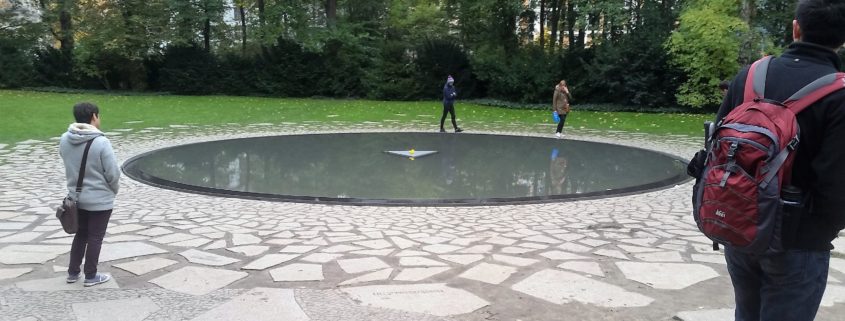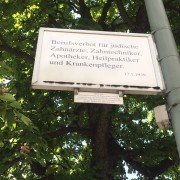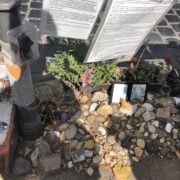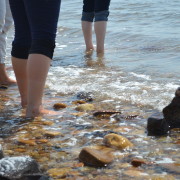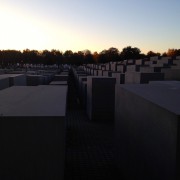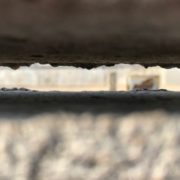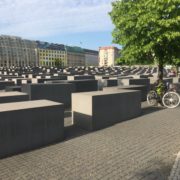German Memorials: Respect, Education and Reconciliation
By Brigitta Pupillo
From the start of our trip in Central Europe there has been a constant theme of suppressing and manipulating history. Our recent trip to Berlin then was refreshing because the city, at least more so than the other places we have visited, takes responsibility for its dark and brutal history, mainly the Nazi Regime. One of the ways Berlin takes responsibility is through its many memorials. My reactions to the memorials around Berlin, ranged a lot. Some of the memorials captivated me, stimulating both my mind and my emotions, while other memorials underwhelmed me. If memorials were just art, it would not matter so much whether I liked or disliked them, but memorials can’t be just left to subjective taste. They are very important as they often reflect the dominant national narrative of the society. They tell locals how they should feel about their history and they educate newcomers to what that history is. Monuments have the potential to provide historical education with far reaching effects; just as a good memorial can educate on the history and support reconciliation, a bad memorial can perpetuate myths about history and prevent reconciliation.
![(Hatlie, M. R. (n.d.). [Memorial To the Vicitms of the Dresden 1945 Bombing]. Retrieved November 9, 2016, from http://sites-of-memory.de/main/dresdenheidefliegeropfer.html )](http://urbanlabsce.eu/wp-content/uploads/2016/11/2.jpg)
(Hatlie, M. R. (n.d.). [Memorial To the Vicitms of the Dresden 1945 Bombing]. Retrieved November 9, 2016, from http://sites-of-memory.de/main/dresdenheidefliegeropfer.html )
 In my opinion the most powerful and successful memorial we visited in Berlin was the one dedicated to the Roma and Sinti who were victims of the Holocaust. The memorial is of great design and not only aesthetically. It is placed near one of the entrances to the Tiergarten and across the street from the Reichstag, where the German’s parliament meets. Even though located in the middle of an area heavily visited by tourists, the monument is sheltered by foliage and shrubbery as well as a blue opaque glass. Engraved into the glass is a timeline of the events of the attempted Genocide of the Roma and Sinti under National Socialism, on the outside of the memorial the information is in English and on the side facing the memorial it is in German. The creator of the memorial, Dani Karavan, a Jewish survivor of the Holocaust, says his intention was to create: “A site of inner sadness, a site for feeling pain, for remembering and not letting the annihilation of the Sinti and Roma by the National Socialist regime fall into oblivion.” (Seemann & Stoltz, n.d.a) The center of the memorial is a black pond with water that is constantly flowing, in the middle of the pond is a triangular stone slab with a small bundle of flowers that are replaced every day as the slab sinks and rises out of the water. All this information can be found in the pamphlet at the sight. The sinking of the stone and the fresh flowers were intended to represent eternal remembering (Seemann & Stoltz, n.d.a). I find the fresh flowers particularly appealing, as it means that the memorial is being taken care of everyday, everyday someone picks the flowers and places them there. The memorial does not just sit there as something of the past but is continually part of the present. On the outer ring of the pond there is a poem by Santino Spinelli:
In my opinion the most powerful and successful memorial we visited in Berlin was the one dedicated to the Roma and Sinti who were victims of the Holocaust. The memorial is of great design and not only aesthetically. It is placed near one of the entrances to the Tiergarten and across the street from the Reichstag, where the German’s parliament meets. Even though located in the middle of an area heavily visited by tourists, the monument is sheltered by foliage and shrubbery as well as a blue opaque glass. Engraved into the glass is a timeline of the events of the attempted Genocide of the Roma and Sinti under National Socialism, on the outside of the memorial the information is in English and on the side facing the memorial it is in German. The creator of the memorial, Dani Karavan, a Jewish survivor of the Holocaust, says his intention was to create: “A site of inner sadness, a site for feeling pain, for remembering and not letting the annihilation of the Sinti and Roma by the National Socialist regime fall into oblivion.” (Seemann & Stoltz, n.d.a) The center of the memorial is a black pond with water that is constantly flowing, in the middle of the pond is a triangular stone slab with a small bundle of flowers that are replaced every day as the slab sinks and rises out of the water. All this information can be found in the pamphlet at the sight. The sinking of the stone and the fresh flowers were intended to represent eternal remembering (Seemann & Stoltz, n.d.a). I find the fresh flowers particularly appealing, as it means that the memorial is being taken care of everyday, everyday someone picks the flowers and places them there. The memorial does not just sit there as something of the past but is continually part of the present. On the outer ring of the pond there is a poem by Santino Spinelli:
Sunken in face
extinguished eyes
cold lips
silence
a torn heart
without breath
without words
no tears.
(Seemann & Stoltz, n.d.b) This poem is in German and in English. In the background, a violin plays quietly, the music is soft and solemn. Lindsey, another member of our small party, I think best summed up the memorial; she said that the space “demanded reverence.” Karavan, when designing the memorial, wanted it to be a place of reflection for both the people who were personally affected by the attempted genocide of the Roma and Sinti, and by those who were not aware of what happened. They both see their reflections in the pond (Seemann & Stoltz, n.d.a). The memorial educates people who do not know about the persecution of the Roma and the Sinti, but most importantly it symbolizes a step towards reconciliation. The opening of the memorial in October 2012 was hosted by the German Chancellor Angela Merkel, and was attended by Romani Rose, the head of the German Central Council of Sinti and Roma. In her speech, Chancellor Merkel stated that the memorial was a promise to protect the victims of the past as well as today’s Roma and Sinti who still suffer from discrimination. Mr. Rose also saw the importance of the location of the memorial right next to the Reichstag, remarking: “I’m thankful that the German government is opening this memorial to the public, and I see its location, so close to the German Parliament, as an attempt to make amends.” (Cottrel, October 24th, 2012) I think these are the indications of a successful memorial, that the people it is dedicated to feel respected, that it is educational, and that it makes steps towards reconciliation.
 The most prominent memorial that we visited was the Memorial to the Murdered Jews of Europe. I remember feeling quite awkward when exploring this memorial because I had expectations of something really moving since this memorial is dedicated to all of the Jews that were killed during World War Two by Nazi Germany and its allies. Yet I felt underwhelmed. The memorial is made up of 2,711 stelae, square concrete columns that start from 0.2 meters high at the edge of the field and 7 meters high at the center (Seemann & Stoltz, n.d.c). The floor of the field is structured like waves, with high and low points. The experience of walking through, at least for me, was unsettling, disorienting, and lonely. The memorial then was successful in doing what the architect, Peter Eisenman, intended for it to represent:
The most prominent memorial that we visited was the Memorial to the Murdered Jews of Europe. I remember feeling quite awkward when exploring this memorial because I had expectations of something really moving since this memorial is dedicated to all of the Jews that were killed during World War Two by Nazi Germany and its allies. Yet I felt underwhelmed. The memorial is made up of 2,711 stelae, square concrete columns that start from 0.2 meters high at the edge of the field and 7 meters high at the center (Seemann & Stoltz, n.d.c). The floor of the field is structured like waves, with high and low points. The experience of walking through, at least for me, was unsettling, disorienting, and lonely. The memorial then was successful in doing what the architect, Peter Eisenman, intended for it to represent:
“…the instability inherent in what seems to be a system, here a rational grid, and its potential for dissolution in time. It suggests that when a supposedly rational and ordered system grows too large and out of proportion to its intended purpose, it in fact loses touch with human reason. It then begins to reveal the innate disturbances and potential for chaos in all systems of seeming order, the idea that all closed systems of a closed order are bound to fail.” (Seemann & Stoltz, n.d.d)
Though the memorial does what Eisenman intended, this quote is what I thinks sums up the major problem with the memorial; that it is too abstract and distant from what it is claiming to represent. When our group was at the memorial we noted how there was nothing that really made it distinct as a memorial. We saw people jumping on top of the blocks, children running through the memorial, and people talking loudly. Things people usually should not do at a memorial as it is disrespectful. But I frankly do not condemn these people because even in our study group, only one of us noticed a small sign placed in the ground that reminds visitors not to jump on the blocks and to remain quiet. If you came in from the one side of the Information Center, then you could probably understand the columns to be a memorial, but when entering form the side facing the Tiergarten or the two sides bordered by busy streets, which are in fact more frequented by people, you would likely not know that you are entering a memorial. Without context the memorial looks like an interesting modern park, something the cool and trendy Berlin would have. Still I knew what the memorial was supposed to represent, I still felt like there was something wrong. The first problem is the memorial’s name – Memorial to the Murdered Jews of Europe. The memorial is officially being presented as a memorial to the European Jews murdered by the Germans during the Holocaust, however, this is not what the architect had in mind. Richard Brody criticized the memorial in his scathing New Yorker article, stating “… it doesn’t say anything about who did the murdering or why—there’s nothing along the lines of “by Germany under Hitler’s regime,” and the vagueness is disturbing.”(July 12, 2012) The abstruseness of the memorial makes more sense when I found out more about who Eisenman thought the memorial was for :
“It’s for the German people. I don’t think it was ever intended to be for the Jews. It’s a wonderful expression of the German people to place something in the middle of their city that reminds them — could remind them — of the past.” (“How Long Does One Feel Guilty?”,May 9, 2005)
It makes sense then that the memorial does not work as a memorial for the Jewish people killed by the Nazis, because it was not intended to. I would argue then that maybe the structure should be renamed. This was a big misstep for everyone involved in creating the monument. In defense, one could say that the people can interpret the work as a memorial, there are people who go and feel moved, but it does not change the fact that that was not the intention. If a memorial reflects what the society thinks then intention does matter. The German government by approving this memorial is giving something to the German people, either a place to think about their history but more accurately a very nice picnic spot in the middle of the city, claiming it for the murdered Jews and then patting themselves on the back for it. I myself am not a part of the Jewish community but this seems incredibly disrespectful and this fails the first criteria of a good memorial, it does not respect the victim. The second criteria is not fulfilled either because the only education you can experience is if you go into the information center which really is separate from the memorial. Berlin and Germany as a whole have done a good job on other memorials and on reconciliation as a whole. This one memorial does not negate those efforts, but the memorial has some saddening implications and hardly functions as a tool of reconciliation.
The last memorial I want to talk about is actually not located in Berlin but I feel it is too important to exclude it from my discussion here. In the Heidefriedhof Cemetery in Dresden, there is a memorial complex that was built by the German Democratic Republic (GDR) as a memorial to the victims of both the concentration camps and to the people who died during the bombings of European cities during World War Two. However, the last stop in the memorial complex is dedicated specifically to Dresden for the 1945 bombing by the Allies. On a large concrete wall, up against the woods, there is a message carved into a concrete wall:
“How many died? Who knows their number? In your wounds we can see the torture of the nameless who burned here in a manmade hell / In memory of the victims of the air attack on Dresden 13-14 February, 1945.” (Hatlie, n.d)
Nothing on the surface seems wrong with this message but the problem is that the number of the people who died in the Dresden bombing is known. The actual of people killed was 3,500 but this number was purposefully exaggerated to 350,000 by the Nazis to create leverage for the post-war trials against the allies. Though the Nazis lost the war the number was not rectified by the GDR, because the Communists still wanted to use Dresden as a symbol of the evil of the West for their own political propaganda. The myth of 350,000 or the language of the “unknown victims” is still used today by the right-winged groups of Dresden, most notably PEGIDA (in English standing for Patriotic Europeans Against the Islamisation of the West). Neo-Nazis also claim that the Dresden bombing was as bad or even worse than the atomic bombings of Hiroshima and Nagasaki. It is important to stress that Dresden was not unlike other European cities that were bombed in WW2 and it was Germany and not the allies that invented the blitzkrieg military tactics. Accurate information is fully accessible after the reunification of Germany, but some people do not want to hear the truth. The memorial means a lot to the people of Dresden but it perpetuates a false reality that is supporting a neo-Nazi movement. It is not respectful to the victims of the bombings to have their deaths be used for politics in this way and the memorial instills misinformation in those who visit it. Memorials inherently are going to be political but once the politics is being placed before the respect for the victims and historical accuracy then I think corrections need to be made. The memorial does not contribute to reconciliation efforts but in fact, damages the reconciliation process by supporting the mythology of today’s neo-Nazi groups.
The beauty in memorials is how they represent something so much larger than what is on the surface. They indicate what a society thinks about their history, the progress they have made, and how they plan to act in the future. Generally they are positive, an outstretched hand to a group of people who have been deeply hurt but they can also be a barrier to peace when they make no efforts or ill efforts at being respectful of people and honest about the past. In Germany the memorials represent the complexities of the national narrative and of reconciliation. By examining the memorials in Dresden and Berlin, the underlying issues can be brought to light.
Sources cited
Brody, R. (2012, July 12). The Inadequacy of Berlin Memorial to the Murdered Jews of Europe. Retrieved November 08, 2016, from http://www.newyorker.com/culture/richard-brody/the-inadequacy-of-berlins-memorial-to-the-murdered-jews-of-europe
Cottrel, C. (2012, October 24). Memorial to Roma Victims of Holocaust Opens in Berlin … Retrieved November 7, 2016, from http://www.nytimes.com/2012/10/25/world/europe/memorial-to-romany-victims-of-holocaust-opens-in-berlin.html
Hatlie, M. R. (n.d.). Memorial complex and mass grave for air raid victims at the Heidefriedhof cemetery in Dresden. Retrieved November 08, 2016, from http://sites-of-memory.de/main/dresdenheidefliegeropfer.html
“How Long Does One Feel Guilty?” [Interview by C. Hawley & N. Tenberg]. (2005, May 9). SPIEGEl. Retrieved November 9, 2016, from http://www.spiegel.de/international/spiegel-interview-with-holocaust-monument-architect-peter-eisenman-how-long-does-one-feel-guilty-a-355252.html
Seemann, U., & Stolz, J. (Eds.). (n.d.a). Stiftung Denkmal für die ermordeten Juden Europas: Dani Karavan. Retrieved November 07, 2016, from http://www.stiftung-denkmal.de/en/memorials/sinti-and-roma-memorial/dani-karavan.html
Seemann, U., & Stolz, J. (Eds.). (n.d.b). Stiftung Denkmal für die ermordeten Juden Europas: Poem by Santino Spinelli. Retrieved November 07, 2016, from http://www.stiftung-denkmal.de/en/memorials/sinti-and-roma-memorial/poem-by-santino-spinelli.html
Seemann, U., & Stolz, J. (Eds.). (n.d.c). Stiftung Denkmal für die ermordeten Juden Europas: The Memorial to the Murdered Jews of Europe. Retrieved November 07, 2016, from http://www.stiftung-denkmal.de/en/memorials/the-memorial-to-the-murdered-jews-of-europe.html
Seemann, U., & Stolz, J. (Eds.). (n.d.d). Stiftung Denkmal für die ermordeten Juden Europas: Peter Eisenman. Retrieved November 08, 2016, from http://www.stiftung-denkmal.de/en/memorials/the-memorial-to-the-murdered-jews-of-europe/peter-eisenman.html

